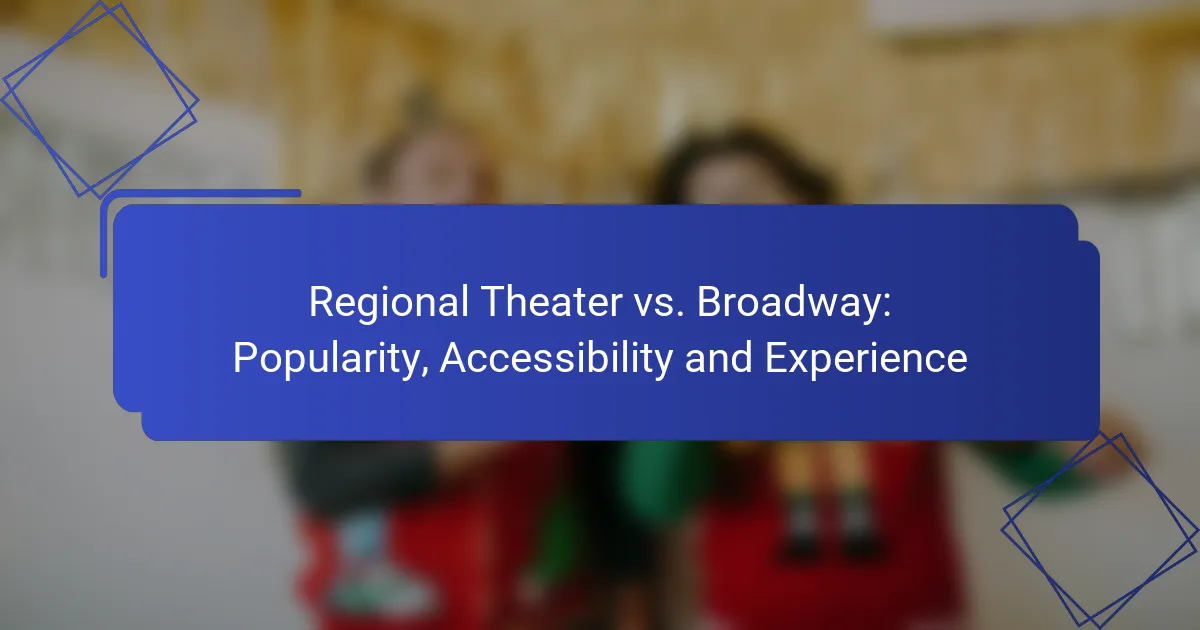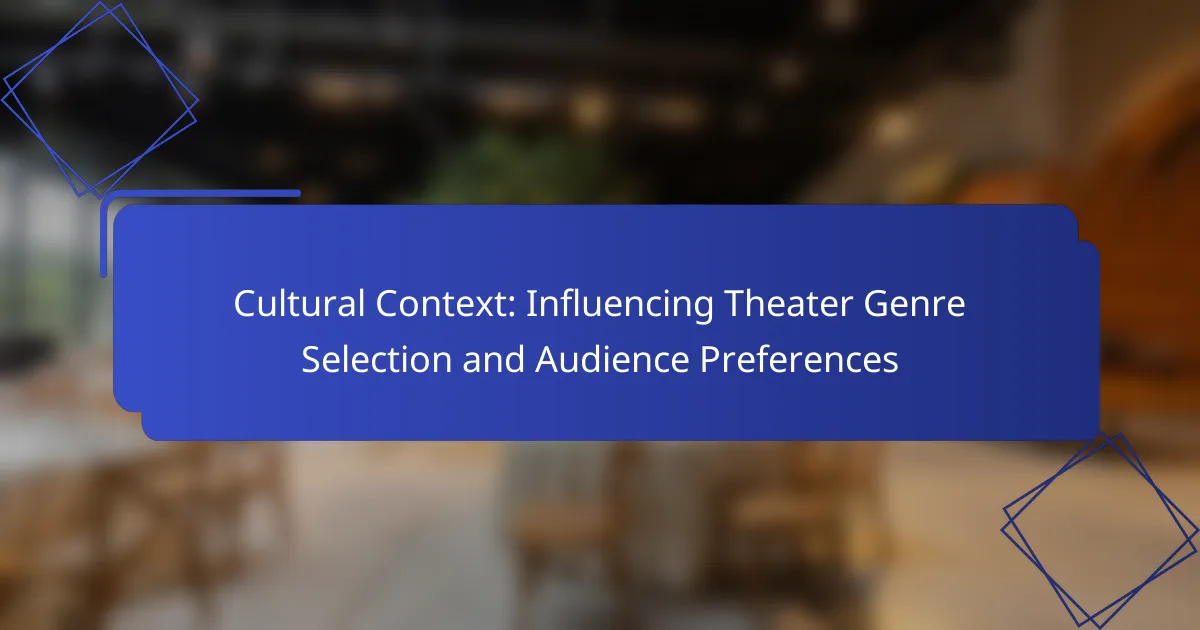Experimental theater plays a vital role in enhancing community engagement and cultural exchange in New York City. By utilizing interactive performances and collaborative projects, it fosters connections among diverse groups while stimulating local economies. This innovative form of art challenges traditional narratives and storytelling methods, inviting audiences to participate in unique and thought-provoking experiences.
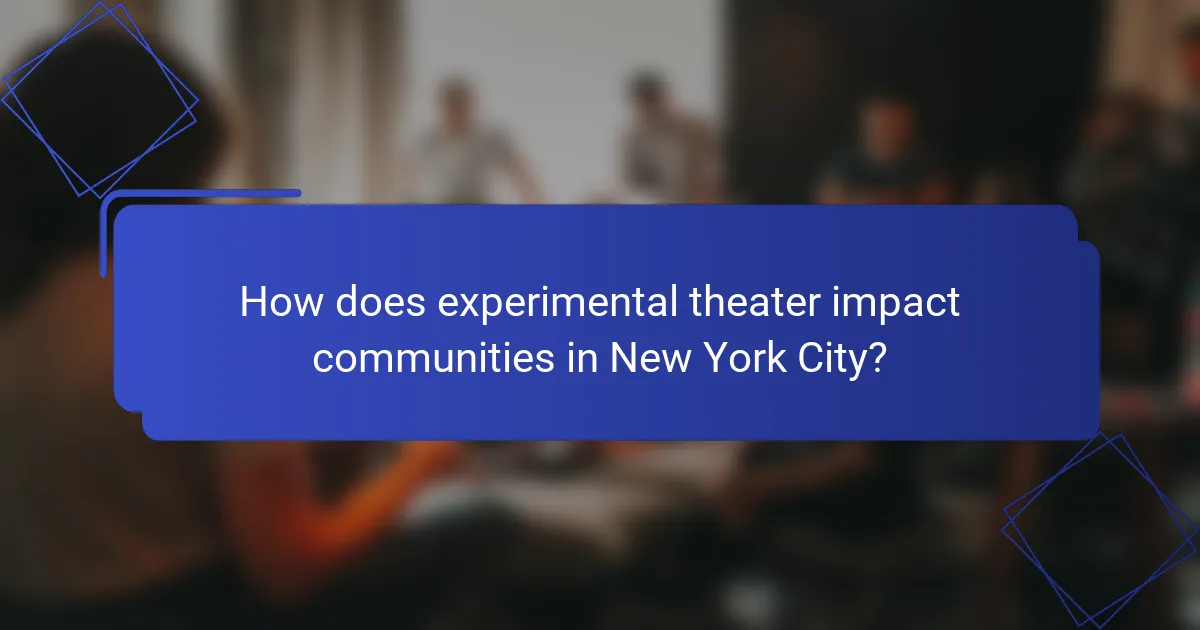
How does experimental theater impact communities in New York City?
Experimental theater significantly impacts communities in New York City by fostering connections among diverse groups, encouraging cultural exchange, and stimulating local economies. These performances often challenge traditional narratives, creating spaces for dialogue and collaboration.
Fostering social cohesion
Experimental theater brings together individuals from various backgrounds, helping to build a sense of belonging and community. By engaging audiences in shared experiences, these performances can break down social barriers and promote understanding among different cultural groups.
For example, community-based theater projects often involve local residents in the creative process, allowing them to express their stories and perspectives. This participatory approach not only strengthens community ties but also empowers individuals to take ownership of their narratives.
Encouraging cultural dialogue
Through innovative storytelling and unique artistic expressions, experimental theater encourages cultural dialogue within New York City. These performances often address pressing social issues, prompting audiences to reflect on their own experiences and engage in discussions about diversity and inclusion.
By showcasing a range of voices and perspectives, experimental theater can challenge stereotypes and promote empathy. Events like panel discussions or post-show Q&As can further enhance this dialogue, allowing audiences to interact with artists and deepen their understanding of the themes presented.
Supporting local economies
Experimental theater plays a vital role in supporting local economies in New York City. By attracting audiences to performances, these productions can generate revenue for nearby businesses, including restaurants, shops, and hotels. This economic boost is particularly significant in neighborhoods where arts and culture are central to community identity.
Moreover, many experimental theater companies hire local talent, from actors to technicians, contributing to job creation within the creative sector. Investing in local arts not only enriches the community but also fosters a vibrant cultural landscape that can attract tourism and further economic development.

What are the key engagement strategies in experimental theater?
Key engagement strategies in experimental theater include interactive performances, community workshops, and collaborative projects. These methods foster deeper connections between artists and audiences, enhancing participation and creativity.
Interactive performances
Interactive performances invite audience participation, breaking the traditional barrier between performers and spectators. This can involve direct engagement, where audience members influence the narrative or outcome, creating a unique experience each time.
For example, a theater company might stage a play where attendees vote on plot twists or character decisions, making them active participants. Consider using technology, such as mobile apps, to facilitate real-time interactions, enhancing the immersive experience.
Community workshops
Community workshops provide a platform for individuals to explore their creativity and learn about the theatrical process. These workshops can range from acting classes to behind-the-scenes production training, allowing participants to gain hands-on experience.
Offering workshops in local community centers or schools can significantly increase engagement. Aim for a mix of free and low-cost options to ensure accessibility, and consider collaborating with local artists to enrich the learning experience.
Collaborative projects
Collaborative projects involve partnerships between artists, community members, and organizations to create theater that reflects local stories and issues. This approach not only diversifies the creative process but also strengthens community ties.
For instance, a theater group might work with local schools to develop a performance based on students’ experiences. Establish clear communication and shared goals among all collaborators to ensure the project is inclusive and impactful.

How does experimental theater drive innovation?
Experimental theater drives innovation by challenging traditional storytelling methods and engaging audiences in new ways. It often incorporates unconventional techniques and formats that push the boundaries of performance art.
Utilizing technology
Experimental theater frequently employs cutting-edge technology to enhance the audience experience and storytelling. This can include the use of projection mapping, virtual reality, and interactive elements that allow viewers to participate in the performance. For instance, a production might use augmented reality to create immersive environments that change based on audience interactions.
When integrating technology, it’s essential to ensure that it complements the narrative rather than distracts from it. A balance between live performance and digital elements can create a more engaging experience.
Exploring new narratives
New narratives in experimental theater often focus on underrepresented voices and unconventional themes. This exploration allows for a broader range of stories that resonate with diverse audiences. For example, a play might tackle social issues through a surreal lens, prompting viewers to reflect on their own experiences.
Writers and directors should consider how to weave personal and collective stories into their work. Engaging with community members during the development process can provide valuable insights and enhance the authenticity of the narratives presented.
Integrating diverse art forms
Integrating various art forms, such as dance, visual arts, and music, is a hallmark of experimental theater. This multidisciplinary approach enriches the performance and creates a unique sensory experience. For example, a production might combine live music with choreography to convey emotions that words alone cannot express.
Collaboration between artists from different disciplines can lead to innovative outcomes. It’s beneficial to establish clear communication and shared goals among collaborators to ensure a cohesive final product that resonates with audiences.
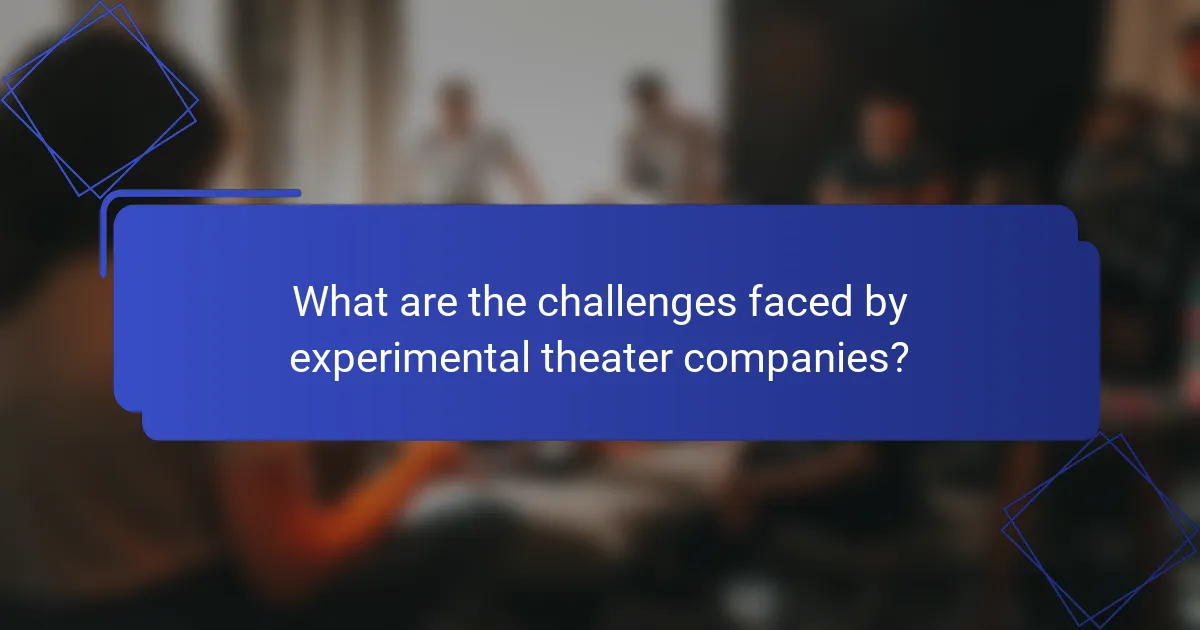
What are the challenges faced by experimental theater companies?
Experimental theater companies encounter several challenges that can hinder their growth and community engagement. Key issues include funding limitations, audience accessibility, and space constraints, each affecting their ability to innovate and connect with the public.
Funding limitations
Funding is a critical challenge for experimental theater companies, often relying on grants, donations, and ticket sales. Many organizations face tight budgets, which can restrict their ability to produce ambitious projects or pay artists adequately.
To navigate funding limitations, companies can explore diverse revenue streams, such as crowdfunding, partnerships with local businesses, or hosting fundraising events. Establishing a strong donor base can also provide more financial stability.
Audience accessibility
Audience accessibility is essential for the success of experimental theater, yet many companies struggle to reach diverse demographics. Factors such as ticket prices, location, and marketing strategies can create barriers for potential attendees.
To improve accessibility, companies should consider offering sliding scale ticket pricing, providing transportation options, or hosting performances in various community spaces. Engaging in targeted marketing efforts can also help attract a broader audience.
Space constraints
Space constraints can limit the creative possibilities for experimental theater companies, as they often lack dedicated venues. This can lead to challenges in staging performances, rehearsals, and community events.
To address space issues, companies might collaborate with local arts organizations or community centers to share facilities. Additionally, utilizing unconventional spaces, such as parks or warehouses, can provide unique settings for performances and enhance audience engagement.
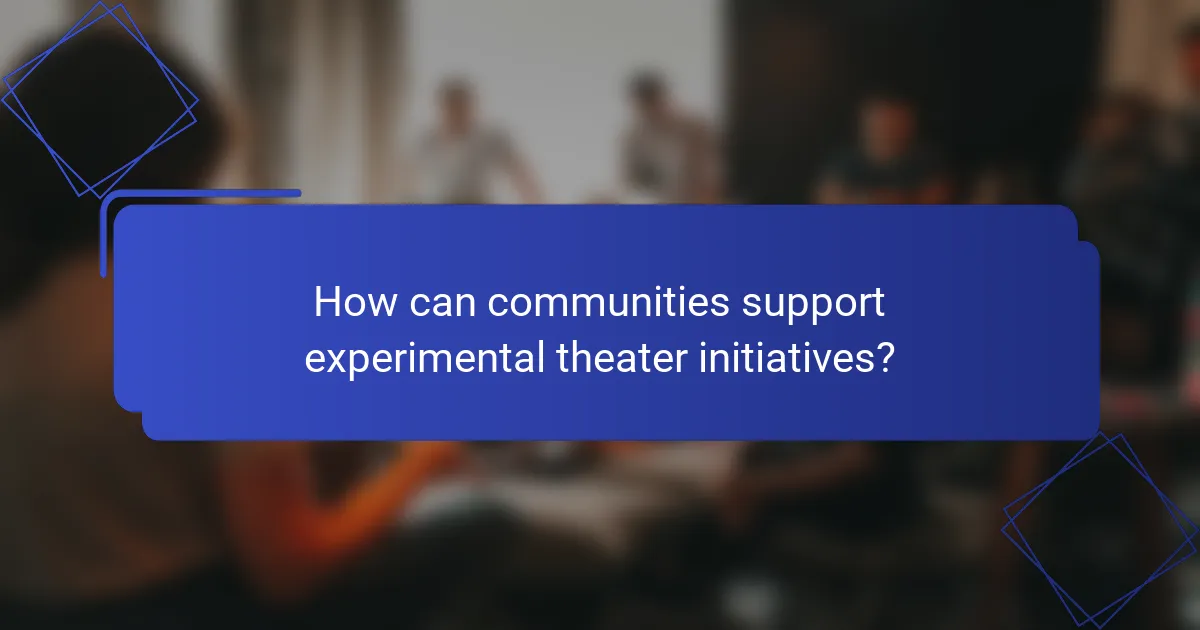
How can communities support experimental theater initiatives?
Communities can support experimental theater initiatives by actively engaging in various ways, including volunteering, providing financial sponsorship, and attending performances. These actions not only enhance local culture but also foster a sense of belonging and creativity among residents.
Volunteer opportunities
Volunteering is a vital way for community members to support experimental theater. Individuals can assist with various tasks such as set design, marketing, or event coordination. Local theaters often seek volunteers for specific events, making it easy to get involved.
Community members can check local theater websites or social media pages for announcements about volunteer needs. Engaging in these opportunities can also provide valuable experience in the arts and networking within the local creative community.
Local sponsorships
Local businesses and organizations can play a crucial role in supporting experimental theater through sponsorships. Financial backing can help cover production costs, venue rentals, and marketing efforts. In return, sponsors often receive promotional benefits, such as advertising in programs or recognition during performances.
Communities should encourage local businesses to consider sponsorship as a way to enhance their visibility while contributing to cultural enrichment. Small to medium-sized enterprises may find that a sponsorship investment can yield significant community goodwill and customer loyalty.
Attending performances
Attending performances is one of the simplest yet most impactful ways to support experimental theater. By purchasing tickets, community members directly contribute to the financial sustainability of local theater companies. Regular attendance can also help build a dedicated audience base that encourages theaters to continue producing innovative works.
Communities can promote attendance by organizing group outings or offering discounts for local residents. Engaging with the theater community through discussions or post-show events can further enhance the experience and foster a deeper connection to the arts.

What are the future trends in experimental theater?
Future trends in experimental theater are leaning towards digital integration, sustainability, and global collaboration. These elements are reshaping how theater engages with audiences and addresses contemporary issues.
Increased digital integration
Digital integration in experimental theater involves the use of technology to enhance storytelling and audience interaction. This can include virtual reality, augmented reality, and live streaming performances, allowing for a broader reach and engagement.
Theaters are increasingly utilizing social media platforms to create immersive experiences and foster community discussions. For instance, some productions invite audience members to participate in real-time decision-making through apps, making the experience more interactive.
Focus on sustainability
Sustainability is becoming a core principle in experimental theater, with companies prioritizing eco-friendly practices in production and performance. This includes using recycled materials for sets and costumes, as well as implementing energy-efficient lighting and sound systems.
Productions are also exploring themes of environmentalism in their narratives, prompting audiences to reflect on sustainability issues. The goal is to not only reduce the ecological footprint of theater but also to inspire social change through art.
Global collaboration opportunities
Global collaboration in experimental theater allows artists from diverse backgrounds to share ideas and create innovative works. This trend is facilitated by digital platforms that enable remote collaboration, breaking geographical barriers.
International festivals and online workshops are examples of how artists can connect and co-create, leading to unique productions that reflect a variety of cultural perspectives. Such collaborations can enrich the theatrical landscape and foster a sense of global community among creators and audiences alike.


